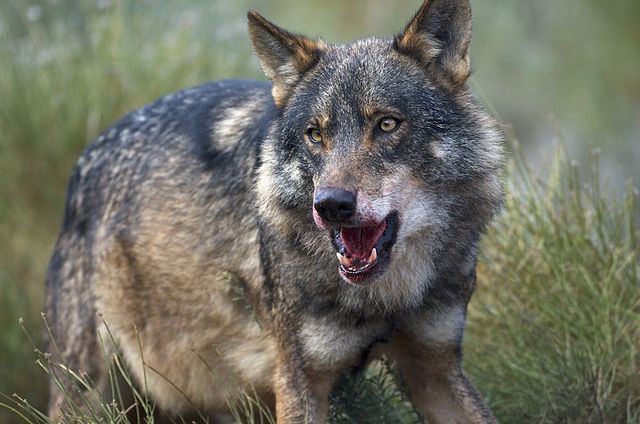 | ||
Similar Megafaunal wolf, Turkestan lynx, Argentine cougar, Mexican bobcat, Madagascan flying fox | ||
The Beringian wolf (Canis lupus ssp) was a hypercarnivorous ecomorph of the gray wolf that once inhabited eastern Beringia (modern day Alaska and the Yukon) and northern Wyoming during the Late Pleistocene era and the early Holocene era. The Beringian wolf is notable because it was the first gray wolf ecomorph to be identified and comprehensively studied using a range of scientific techniques, which revealed for the first time the feeding behavior of prehistoric wolves. It was similar in size to the modern Alaskan wolf and other Late Pleistocene wolves but was more robust with a shorter, broader palate and large carnassial teeth relative to its skull size. This adaptation allowed it to produce relatively large bite forces, grapple with large struggling prey, and therefore to predate and scavenge on megafauna. With the close of the Late Pleistocene and the extinction of its prey, the Beringian wolf went extinct in North America. However, recent DNA analysis has identified genetically identical wolves living today in remote China and Mongolia.
Contents
- Taxonomy and evolution
- Basal wolf
- Two types of wolf
- Adaptation
- Paleoecology
- Prey
- Skull and dentition
- Behaviour
- Tooth breakage
- Competitors
- Range
- Extinction
- Ecomorph is extinct
- Haplotype is not extinct
- References

Taxonomy and evolution
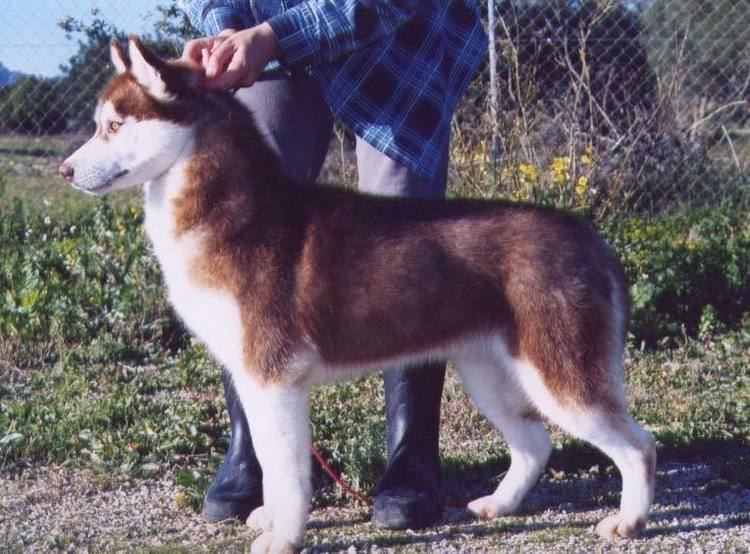
In 1975, a study was undertaken of canid remains dated to the Late Pleistocene era (126,000-11,700 years ago) and early Holocene era (11,700 years ago until today) that had been uncovered decades earlier by miners around Fairbanks, Alaska and described as "short-faced wolves". Based on their morphology, these were classified as Canis lupus (Gray wolf). Later genetic analyses supported this classification. The specimens were not assigned a Canis lupus sub-species name but the name "eastern Beringian wolf" was used to describe them. Beringia was an area of land that once spanned the Bering Sea and the Chukchi Sea from Eurasia to North America when these wolves existed. Ancient specimens of wolves with similar skull and dentition have been found in western Beringia (northeast Siberia), the Taimyr Peninsula, the Ukraine, and in Germany where the European specimens are classified as Canis lupus spelaeus—the cave wolf.
Basal wolf
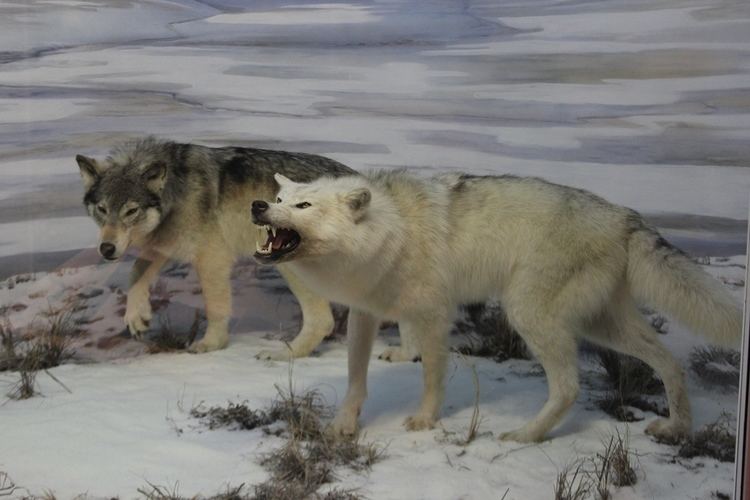
DNA sequences can be mapped as a phylogenetic tree. A phylogenetic tree represents evolutionary relationships, with each branch point representing the proposed divergence of two lineages from a common ancestor. "The term basal taxon refers to a lineage that diverges early in the history of the group and lies on a branch that originates near the common ancestor of the group." Studies have found the Beringian wolf to be basal to all other gray wolves except for the extant Indian gray wolf, the extant Himalayan wolf, and the extinct Belgian clade.
Two types of wolf
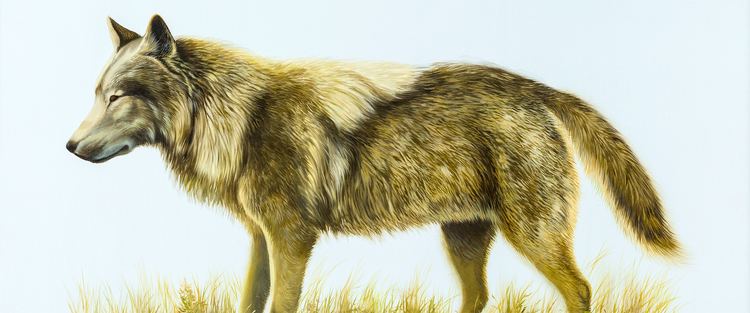
A haplotype (short for a haploid genotype) is a group of genes found in an organism that are inherited together from a single parent. A haplogroup is a group of similar haplotypes that share a common ancestor with a single-nucleotide polymorphism (a mutation). Mitochondrial DNA passes along the maternal line and can date back thousands of years. A study of the DNA sequences that were 425 base pairs in length recovered from the mitochondrial control region of 20 eastern Beringian wolves yielded 16 haplotypes that were not found in modern wolves. This was compared with 7 haplotypes found in a sample of 32 modern Alaskan and Yukon wolves. This suggests that there was once greater wolf diversity, and therefore a larger wolf population, than for modern wolves.
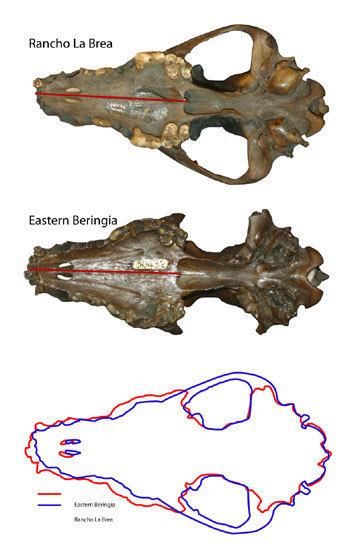
A later study compared DNA sequences that were 230 base pairs in length from the mitochondrial control region recovered from 24 ancient wolf specimens from western Europe dated between 44,000–1,200 years before present (YBP) with those of modern gray wolves. Most of the sequences could be represented on a phylogenetic tree. However, the haplotypes of the Himalayan wolf and the Indian gray wolf were not because they were 8 mutations apart from the other wolves, clearly indicating distinct lineages which had previously been found in other studies. The study found that the other wolf sequences could be allocated to two haplogroups that were separated from each other by 5 mutations. Haplogroups 1 and 2 could be found spread across Eurasia but only haplogroup 1 could be found in North America. The ancient wolf samples from western Europe differed from modern wolves by 1 to 10 mutations, and all belonged to haplogroup 2 indicating its predominance in this region for over 40,000 years both before and after the Last Glacial Maximum. A comparison of current and past frequencies indicated that in Europe haplogroup 2 became outnumbered by haplogroup 1 over the past several thousand years but in North America haplogroup 2—represented by the Beringian wolf—became extinct and was replaced by haplogroup 1 after the Last Glacial Maximum.

A scenario has been proposed that is consistent with the phylogenetic, ice sheet size and sea-level depth data. During the Late Pleistocene when sea levels were at their lowest, there was a single wave of wolf colonization into North America commencing with the opening of the Bering land bridge 70,000 YBP and ending with the closing of the Yukon corridor that ran between the division between the Laurentide Ice Sheet and the Cordilleran Ice Sheet 23,000 YBP during the Late Glacial Maximum. As wolves had been in the fossil record of North America but modern wolves could trace their genetic ancestry back only 80,000 years, the wolf haplotypes that were already in North America were replaced by these invaders, either through competitive displacement or through admixture. The replacement in North America of a basal population of wolves by a more recent one supports the findings of earlier studies. There possibly existed a panmictic wolf population with gene flow spanning Eurasia and North America until the closing of the ice sheets. Once the sheets closed, the southern wolves were isolated and north of the sheets only the Beringian wolf existed. The land bridge became inundated by the sea 10,000 YBP and the ice sheets receded 12,000–6,000 YBP. The Beringian wolf went extinct and the southern wolves expanded through the shrinking ice sheets to recolonize the rest of North America. All North American wolves are descended from those that were once isolated south of the ice sheets. However, much of their diversity was later lost during the twentieth century.
Adaptation
Adaptation is the evolutionary process whereby an organism becomes better able to live in its habitat or habitats. Ecological factors including habitat type, climate, prey specialization and predatory competition will greatly influence gray wolf genetic population structure and cranio-dental plasticity, which is the evolutionary adaption of the skull and teeth. Therefore, within the Pleistocene gray wolf population the variations between local environments would have encouraged a range of wolf ecotypes that were genetically, morphologically and ecologically distinct from one another. The Beringian wolf ecomorph demonstrates evolutionary cranio-dental plasticity not previously seen in North American gray wolves.
Paleoecology
The Late Pleistocene, also referred to as the last Ice Age, spanned 126,000 YBP–11,700 YBP. The Ice Age reached its peak during the Last Glacial Maximum, when ice sheets commenced advancing from 33,000 YBP and reached their maximum positions 26,500 YBP. During the Ice Age a vast, cold and dry Mammoth steppe stretched from Spain eastwards across Eurasia and from the arctic islands southwards to China, and over the Bering land bridge into Alaska and the Yukon where it was stopped by the Wisconsin glaciation. Therefore, the flora and fauna of Beringia was more related to those of Eurasia rather than the rest of North America. Beringia was a refuge for animals and plants because it received more moisture from the Pacific ocean than the rest of the Mammoth steppe. The land bridge existed because more of the planet's water was locked up in glaciation than now and therefore the sea-levels were lower. Deglaciation commenced in the Northern Hemisphere approximately 19,000 YBP and in Antarctica approximately 14,500 years YBP. This led to rising sea levels and the bridge was finally inundated around 10,000 YBP and the mammoth steppe all but disappeared.
See further: Beringian refugiumPrey
Stable isotope analysis measures the amount of different isotopes of the same element contained within a specimen. When conducted on the bone of an extinct specimen, it informs researchers about the diet of the specimen. Stable isotope analysis conducted on the remains of Late Pleistocene wolves found in Beringia and Belgium indicate that they both preyed mainly on Pleistocene megafauna, which became rare at the beginning of the Holocene 12,000 years ago. The Beringian wolf ate largely horse and steppe bison. In the pre-galacial period (50,000 YBP - 23,000 YBP) they also ate woodland muskox, and after this time they also ate mammoth. This analysis supports the conclusion that they were capable of killing and dismembering large prey. In another stable isotope analysis, half of the Beringian wolf specimens were found to be muskox and caribou specialists, and the other half were horse and bison specialists or generalists. Two wolves from the full-glacial period (23,000–18,000 YBP) were found to be mammoth specialists but it is not clear if this was due to scavenging or predation. An analysis of carnivore fossils from the Fairbanks region of Alaska found that mammoth was rare in the diets of the Beringian carnivores, which included Beringian wolves, Beringian cave lions, short-faced bears and the omnivorous brown bear.
Skull and dentition
Dentition relates to the arrangement of teeth in the mouth. Dental notation for the upper-jaw teeth uses the upper-case letters I to denote incisors, C for canines, P for premolars, and M for molars, and the lower-case letters i, c, p and m to denote the mandible teeth. Teeth are numbered using one side of the mouth and from the front of the mouth to the back. In carnivores, the upper premolar P4 and the lower molar m1 form the carnassials, which are used together in a scissor-like action to shear the muscle and tendon of prey.
The Beringian wolf was similar in physical size to the extant Alaskan wolf, and the Late Pleistocene wolves whose remains have been found in the La Brea Tar Pits at Los Angeles, California. The wolves from Rancho La Brea are not physically different from Holocene gray wolves, with the only difference being a larger tibial tuberosity that is the insertion for the quadriceps and hamstring muscles, suggesting a more powerful take-off for the chase. However, the Beringian wolf was more robust with stronger jaws and teeth compared with both of these. Beringian wolves had short, broad palates with large carnassials relative to their overall skull size. The row length of their premolars was longer, the P4 premolar (the upper carnassial) longer and wider, and the M1, M2, and m1 (the lower carnassial) molars longer than those found in other wolves. The short, broad rostrum increased the mechanical advantage of a bite made with the canine teeth and also strengthened the skull against torsional stresses that could be caused by struggling prey. Relatively deep jaws are found today in the bone-cracking spotted hyena or in canids that are adapted to taking large prey. These features indicate that Beringian wolves were hypercarnivorous and with a craniodental morphology more capable of capturing, dismembering, and consuming the bones of very large megaherbivores. They were more specialized than their Rancho La Brea counterparts and modern gray wolves in the taking and consuming of relatively large prey and for scavenging.
Behaviour
Canids tend to live as monogamous pairs, and in the case of wolves, dholes, and jackals also along with their offspring. Extra-pair copulations are not uncommon, however fighting between males for access to females is rarely seen. Sexual dimorphism is the difference between the male and female of a species apart from their sex organs. There is little dimorphism variance among the canids regardless of their group size. This is compared to the lion, where the male possesses a mane, larger size, larger upper canines, and operates in a group of no more than two or three. Canids cannot use their limbs to grapple with their prey compared to felines, and rely on their jaws and working together in a pack when taking prey larger than themselves. For the gray wolf, African wild dog, and the dhole, a pack usually consists of an alpha pair and their offspring from current and previous years. Wolves may live in extended family groups.
Tooth breakage
Tooth breakage is related to a carnivore's behaviour. A study of nine modern carnivores indicate that one in four adults had suffered tooth breakage and that half of these breakages were of the canine teeth. The highest frequency of breakage occurred in the spotted hyena that is known to consume all of its prey including the bone. The least breakage occurred in the African wild dog. The gray wolf ranked between these two. The eating of bone increases the risk of accidental fracture due to the relatively high, unpredictable stresses that it creates. The most commonly broken teeth are the canines, followed by the premolars, carnassial molars, and incisors. Canines are the teeth most likely to break because of their shape and function, which subjects them to bending stresses that are unpredictable in direction and magnitude. The risk of tooth fracture is also higher when taking large prey.
Another study found that in comparison to extant gray wolves, Beringian wolves included many more individuals with moderately to heavily worn teeth and with a significantly greater number of broken teeth. The frequencies of fracture ranged from a minimum of 2% found in the Northern Rocky Mountain wolf (Canis lupus irremotus) up to a maximum of 11% found in Beringian wolves. The distribution of fractures across the tooth row also differs, with Beringian wolves having much higher frequencies of fracture for incisors, carnassials, and molars. A similar pattern was observed in spotted hyenas, suggesting that increased incisor and carnassial fracture reflects habitual bone consumption because bones are gnawed with the incisors and then cracked with the carnassials and molars.
Dental microwear analysis uses a light microscope to view small abrasions caused by wear on the surface of the teeth to form opinions about the chewing habits and diet of extinct species. In 2015, a study of the dental microwear on tooth enamel was undertaken on specimens of all of the carnivore species that had been found at Rancho La Brea, including remains of the large wolf Canis dirus guildayi (dire wolf) that was also a megafaunal hypercarnivore and that also exhibited a high frequency of tooth breakage. The evidence suggests that these carnivores were not food-stressed just before extinction and that carcass utilization was less than among modern large carnivores. The high incidence of tooth breakage was proposed to be due to the taking and consuming of larger prey.
Competitors
The competitors of the Beringian wolf included the Saber-toothed cat, Beringian cave lion, bears (ursids), dhole, and Pleistocene coyote. One study found that the Pleistocene coyote from 10,000 years ago was more carnivorous, much larger, and with a skull and jaws significantly thicker and deeper than those of modern coyotes. Compared to modern wolves, the high frequency of tooth fracture in Beringian wolves indicates higher carcass consumption due to higher carnivore density and increased competition. Additionally, humans had reached the Bluefish Caves in the Yukon Territory by 24,000 YBP, introducing a new competitor for large game.
Range
Beringian wolves have been found in Alaska and as far eastward as the Yukon in Canada. They are morphologically and genetically comparable to Late Pleistocene European wolves and two studies found that some share a common haplotype, which makes ecological similarity likely. A study found that a wolf from the Nerubajskoe-4 Paleolithic site, Ukraine dated 30,000 YBP, a wolf from the Zaskalnaya-9 Paleolithic site, Ukraine dated 28,000 YBP, and the "Altai dog" from the Altai Mountains of Central Asia dated 33,000 YBP had the same sequence as six Beringian wolves (indicating a common maternal ancestor). Another wolf from the Vypustek cave, Czech Republic dated 44,000 YBP had the same sequence as two Beringian wolves (indicating another common maternal ancestor).
The Beringian wolves are phylogenetically associated with a distinct group of 4 modern European haplotypes (but these are not their direct descendents), which indicates that both ancient and extant North American wolves originated in Eurasia. Two of these 4 haplotypes includes one only found in the Italian wolf and one only found in Rumania. These 4 haplotypes fall with all of the Beringian wolf haplotypes under mDNA haplogroup 2. Ancient specimens of wolves with similar skull and dentition have been found in western Beringia, the Taimyr Peninsula, the Ukraine, and in Germany.
Specimens that have been identified by their skull morphology to be Beringian wolves have been found in the Natural Trap Cave at the base of the Bighorn Mountains in Wyoming, United States. These were radiocarbon dated between 25,800-14,300 YBP and this location is directly south of what would at that time have been the division between the Laurentide Ice Sheet and the Cordilleran Ice Sheet. This suggests that a temporary channel existed between the glaciers from 25,800 YBP until the advance of the ice sheets 16,000-13,000 YBP. The migration of the Beringian wolf is assumed to have been the result of pursuing prey species, as this cave also contained specimens of steppe bison that had migrated from Beringia and would have been prey for wolves, and muskox that is known to be an important prey species of the Beringian wolf. Dire wolves were absent north of 42°N latitude in the Late Pleistocene, therefore this region would have been available for Beringian wolves to expand southwards. There is no evidence of expansion beyond this region. Another study of bison through this area indicated that this corridor was closed between 23,000 YBP until 13,400 YBP, and if this is correct then it suggests that the wolves were able to migrate south between 23,800-23,000 YBP but were then unable to return north due to this corridor being closed.
Extinction
Extinction is the result of the elimination of the geographic range of a species with a reduction of its population size down to zero. The factors that affect biogeographic range and population size include competition, predator/prey interactions, variables of the physical environment, and chance events.
Ecomorph is extinct
The American megafaunal extinction event commenced 12,700 YBP when 90 genera of mammals weighing over 44 kilograms became extinct. The extinction of the large carnivores and scavengers is thought to be caused by the extinction of the megaherbivore prey on which they depended. The Late Pleistocene was characterized by a series of severe and rapid climate oscillations with regional temperature changes of up to 16 °C, which has been correlated with Pleistocene megafaunal extinctions. There is no evidence of megafaunal extinctions at the height of the Last Glacial Maximum, indicating that increasing cold and glaciation were not factors. Multiple events appear to have caused the rapid replacement of one species by one within the same genus, or one population by another within the same species, across a broad area. As some species became extinct, so too did the predators that depended on them.
The radio carbon dating of the skeletal remains from 56 Beringian wolves showed a continuous population from over 50,800 YBP until 12,500 YBP, and then one wolf dated at 7,600 YBP. This indicates that their population was in decline after 12,500 YBP, although megafauna was still available in this region until 10,500 YBP. The timing of this latter specimen is supported by the recovery of mammoth and horse DNA from sediments dated 10,500 YBP–7,600 YBP from the interior of Alaska. The timing for the extinction of horses in North America and the minimum population size for North American bison coincide with the extinction of an entire wolf haplogroup in North America, indicating that the disappearance of their prey caused the extinction of this wolf ecomorph. This resulted in a significant loss of phenotypic and genetic diversity within the species.
The large Late Pleistocene carnivores that were more carnivorous than their competitors faced greater vulnerability to extinction. The Beringian cave lion, saber-toothed cat, and short-faced bear went extinct at the same time as their large megafaunal prey. The more generalist coyote, American black bear, brown bear, puma and bob-cat survived. Both the Beringian wolf and the dire wolf went extinct in North America, leaving only the less carnivorous and more gracile form of the wolf to thrive. Another extinction proposal is the Beringian wolf was outcompeted and replaced by the ancestor of the modern gray wolf.
Haplotype is not extinct
In 2016, a study compared DNA sequences that were 582 base pairs in length from the mitochondrial control region of ancient wolf specimens and modern wolves, including specimens from the remote regions of North America, Russia and China. One ancient haplotype that had once existed in both Alaska (Eastern Beringia 28,000 YBP) and Russia (Medvezya "Bear" Cave, Pechora area, Northern Urals 18,000 YBP) was shared with some modern wolves found living in China and Mongolia. A previous study had identified two wolf haplogroups, however these were not clearly seen in this study, which used a DNA sequence length twice as large as the previous study. The study concurred that the genetic diversity of past wolves has been lost at the beginning of the Holocene in Alaska, Siberia, and Europe and there was limited overlap with modern wolves. For the ancient wolves of North America, instead of an extinction/replacement model suggested by a previous study, this study found substantial evidence of a population bottleneck (reduction) in North America in which the ancient wolf diversity was almost lost at the beginning of the Holocene. In Eurasia, the loss of many ancient lineages could not be simply explained and appears to have been slow across time with the reasons unclear.
